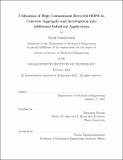| dc.contributor.advisor | Alexander Slocum. | en_US |
| dc.contributor.author | Southerland, Sarah(Sarah Jenesen) | en_US |
| dc.contributor.other | Massachusetts Institute of Technology. Department of Mechanical Engineering. | en_US |
| dc.date.accessioned | 2021-05-25T18:23:39Z | |
| dc.date.available | 2021-05-25T18:23:39Z | |
| dc.date.copyright | 2021 | en_US |
| dc.date.issued | 2021 | en_US |
| dc.identifier.uri | https://hdl.handle.net/1721.1/130867 | |
| dc.description | Thesis: S.M., Massachusetts Institute of Technology, Department of Mechanical Engineering, February, 2021 | en_US |
| dc.description | Cataloged from the official PDF version of thesis. | en_US |
| dc.description | Includes bibliographical references (pages 155-161). | en_US |
| dc.description.abstract | Recycled HDPE (rHDPE) has many applications both in consumer and industrial applications. The main drawbacks of the rHDPE are 1) material property inconsistencies and 2) the difficulty of sorting out contaminants, which includes dirt, food remnants and objects that are not the expected material, from recycled items. Up until 2018, China was a critical destination for much of the world's recycled materials where it was sorted, cleaned, and processed into pellets to form new products. In 2018, China changed their import laws forcing the US and others to redevelop their recycling supply chain. This upended the market for contaminated recyclables creating an opportunity for utilization of this material. This research aims to utilize rHDPE plastic with an undesirably high contamination rate produced by single stream recycling centers, and investigate potential market opportunities to capitalize an otherwise less desirable recycling stream. Currently U.S. | en_US |
| dc.description.abstract | Reclaimer facilities that make new pellets from recycled plastics want to purchase recycled material with a contamination rate of 1%, but recycling centers are producing bales with closer to 7 to 10% contamination. The goal of this thesis is to investigate utilization of 1% to 10% contaminated recycled HDPE material with the primary focus on rHDPE as a concrete aggregate substitute. Concrete accounts for 4% to 8% of the world's carbon emissions [1]. The US consumed 102 million metric tons of concrete in 2019 which contributed 10.4 million metric tons of CO2 emissions [2]. As a concrete additive, rHDPE could contribute to a reduction in the consumption of concrete aggregate materials and become an avenue for carbon sequestration. The hypothesis, developed from previous work by Michael Short and team[3], is that dirty rHDPE can be shredded and surface activated using gamma radiation to create better adhesion between shredded components and/or adjacent materials. | en_US |
| dc.description.abstract | Material treated in this manor is also hypothesized to bond better to itself to enable use in alternative applications such as drainage pipes, plastic pallets, or other applications where porosity can be tolerated. The research entails designing and building a deterministically designed plastic shredder to shred collected recycled HDPE for testing of concrete samples made with various forms of the plastic: rinsed, fully cleaned, and contaminated rHDPE. Prepared sample sets were exposed to gamma radiation to activate the surface for improved bonding to concrete and aggregate. Treated and untreated materials were added to M15 mixed concrete substituting 1.25% aggregate for rHDPE. The resulting concrete test cylinders were compression tested and compared to unaltered M15 concrete as a control. The results showed that gamma-treated rHDPE concrete samples had the same ultimate compressive strength as the control while the untreated samples showed significantly worse performance. | en_US |
| dc.description.abstract | The experiments also showed that "dirty" rHDPE did not degrade the performance of the gamma-treated samples. The results were promising that a higher percentage of contamination may be acceptable more than the previous standard. Specifically, this thesis explores methods for using plastic in various states of cleanliness in different products, with the ideal goal of showing contaminated rHDPE can be activated with ionizing radiation so cement can adhere to it, and thus enable its use as a additive in concrete to increase strength and offset the use of crushed stone. The United States recycles 635.9 thousand metric tons of colored HDPE products per year which if utilized as concrete aggregates could save 65.2 thousand metric tons of CO2 per year from the reduction in aggregate consumed. With US Recycling facilities searching for new buyers and the market value for single family curb side recycling drooping almost 50% in the last two years [4]. | en_US |
| dc.description.abstract | rHDPE embedded concrete could be a new market opportunity to absorb the recycling stream as well as reduce the carbon footprint of concrete by reducing aggregate consumption. | en_US |
| dc.description.statementofresponsibility | by Sarah Southerland. | en_US |
| dc.format.extent | 161 pages | en_US |
| dc.language.iso | eng | en_US |
| dc.publisher | Massachusetts Institute of Technology | en_US |
| dc.rights | MIT theses may be protected by copyright. Please reuse MIT thesis content according to the MIT Libraries Permissions Policy, which is available through the URL provided. | en_US |
| dc.rights.uri | http://dspace.mit.edu/handle/1721.1/7582 | en_US |
| dc.subject | Mechanical Engineering. | en_US |
| dc.title | Utilization of high contaminant recycled HDPE in concrete aggregate and investigation into additional industrial applications | en_US |
| dc.type | Thesis | en_US |
| dc.description.degree | S.M. | en_US |
| dc.contributor.department | Massachusetts Institute of Technology. Department of Mechanical Engineering | en_US |
| dc.identifier.oclc | 1252632167 | en_US |
| dc.description.collection | S.M. Massachusetts Institute of Technology, Department of Mechanical Engineering | en_US |
| dspace.imported | 2021-05-25T18:23:39Z | en_US |
| mit.thesis.degree | Master | en_US |
| mit.thesis.department | MechE | en_US |
